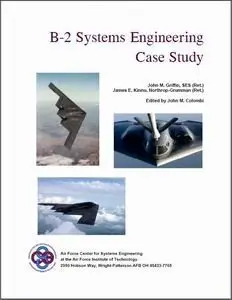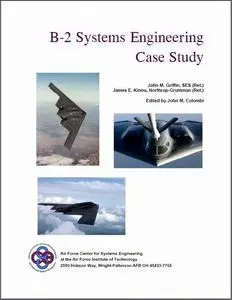B-2 Systems Engineering Case Study by: John M. Griffin, James E. Kinnu, John M. Colombi
Air Force Center for Systems Engineering, Air Force Institute of Technology 2007 | 2950 Hobson Way, Wright Patterson AFB, OH 45433-7765
118 Pages | ISBN no | PDF | 8 MB
Air Force Center for Systems Engineering, Air Force Institute of Technology 2007 | 2950 Hobson Way, Wright Patterson AFB, OH 45433-7765
118 Pages | ISBN no | PDF | 8 MB
The B-2 Systems Engineering Case Study describes the application of systems engineering during the concept exploration, design, and development of the USAF B-2 Spirit stealth bomber. The case examines and explores the systems engineering process as applied by the Air Force B-2 System Program Office, the prime contractor, Northrop, and the two major subcontractors, Boeing and Vought, from the program’s genesis in the late 1970s to the first flight of the first aircraft on 17 July 1989. The systems engineering process is traced from a vision of a few planners in 1978 to the production of 21 operational aircraft that are currently serving our nation. Numerous interviews were conducted with the principals who managed and directed the program and a story of the systems engineering process emerged.
The B-2 was conceived to profit from the advances in stealth technology that grew from a series of laboratory experiments and design studies during 1970 to 1976. The early work by both the government and industry during this timeframe resulted in feasible and practical stealth vehicles that exist throughout our military. The current operational fleets of fighters, bombers, UAVs, ships, and other stealth vehicles trace their heritage to the early technology maturation and engineering development programs. Stealth (or low observables, as it was called by the original practitioners) offered a new and revolutionary approach for penetrating the burgeoning growth of the Soviet defensive system of an integrated radar network. The fighter was the first type of weapon system to be studied for the benefits of stealth and the pay-off was assessed as substantial. The bomber was the next obvious candidate, and it too, showed great promise. Lockheed was in the lead for the technology application for fighters and was awarded the development contract for the F-117 stealth fighter. Northrop and Lockheed were competitors for the contract to develop the stealth bomber from late 1979; Northrop won the contract in November 1981. The first flight of the B-2 was 17 July 1989 with the first operational sortie of the aircraft occurring during the Balkan conflict in December 1995.
The Spirit is a long-range heavy bomber incorporating the key technologies of the time. First, it is a highly efficient flying-wing (tailless) aeronautical design. Secondly, the aircraft makes extensive use of composite materials. And third, it is designed for stealth. Figure 1 shows four views of the aircraft with each view showing the details of the control surfaces, doors, access panels, and other external features. Note the center of the aircraft from the bottom view, showing the large cut out of the structure to accommodate the weapons bay doors (4), engine access doors (4), and the main landing gear doors (2). The ability to achieve an efficient structural design in the presence of the large cutouts on the bottom skin of the vehicle is one of the significant achievements of the structures team.
The B-2 has significant range performance and payload capability. Table 1 shows the design weights and the range and payloads for the nuclear mission as well as the conventional missions. The bomber was primarily designed as a long-range strategic nuclear delivery system, but a significant conventional capability was designed in from the beginning. The table shows an abbreviated list of weapons currently certified for carriage. The list of weapons carriage capability continues to expand through ongoing B-2 modernization programs.



